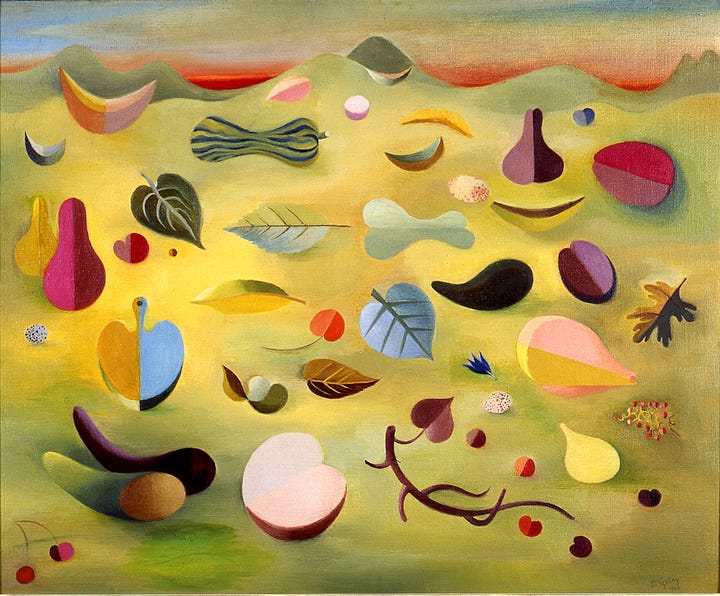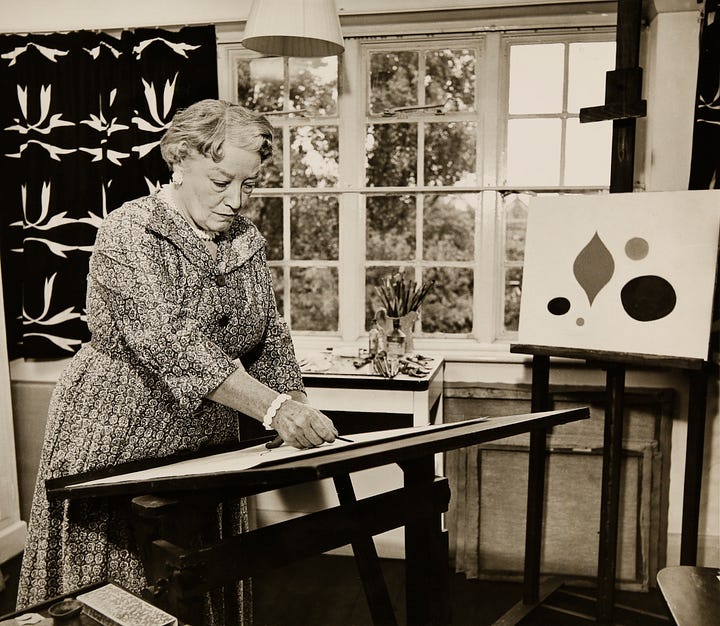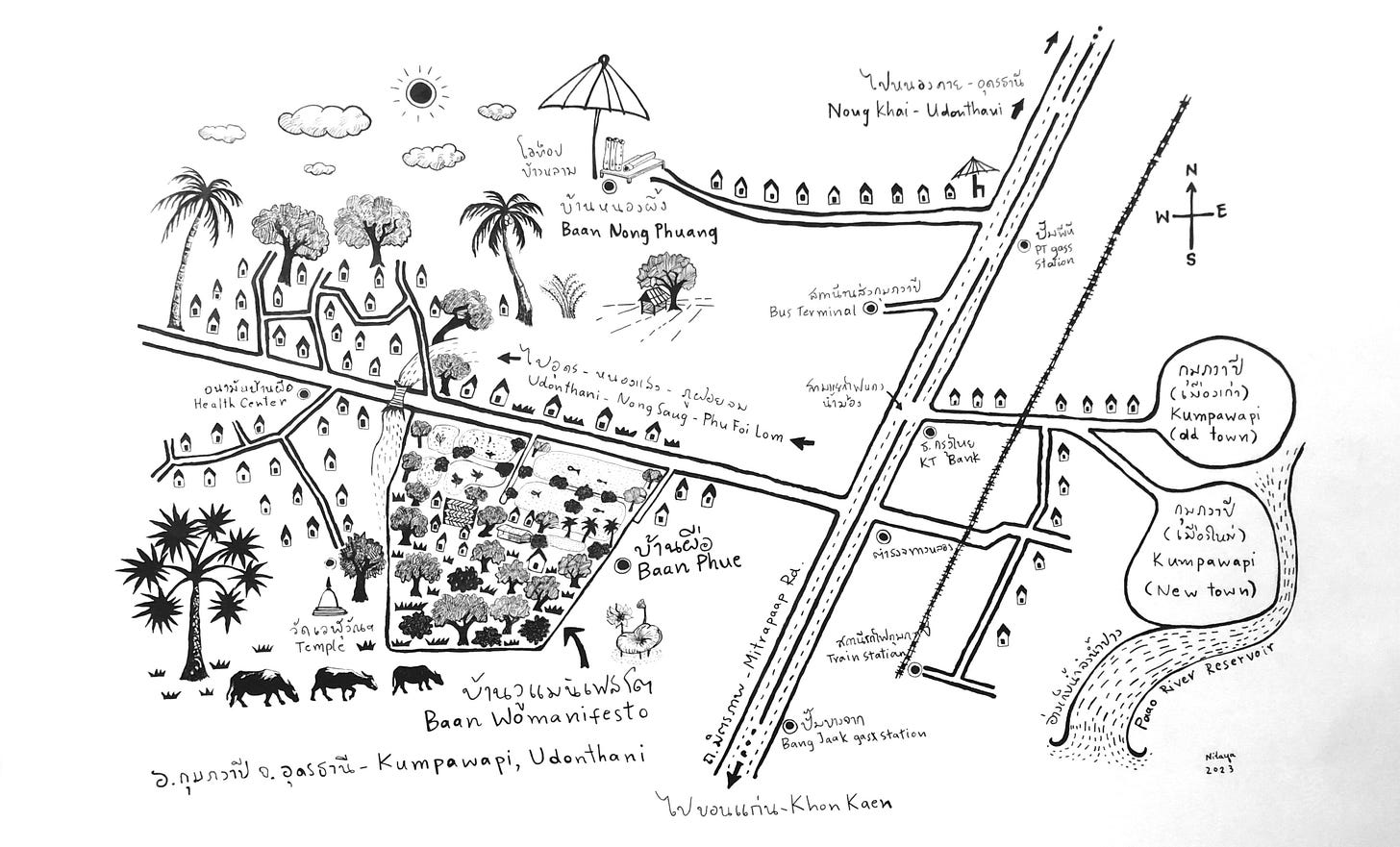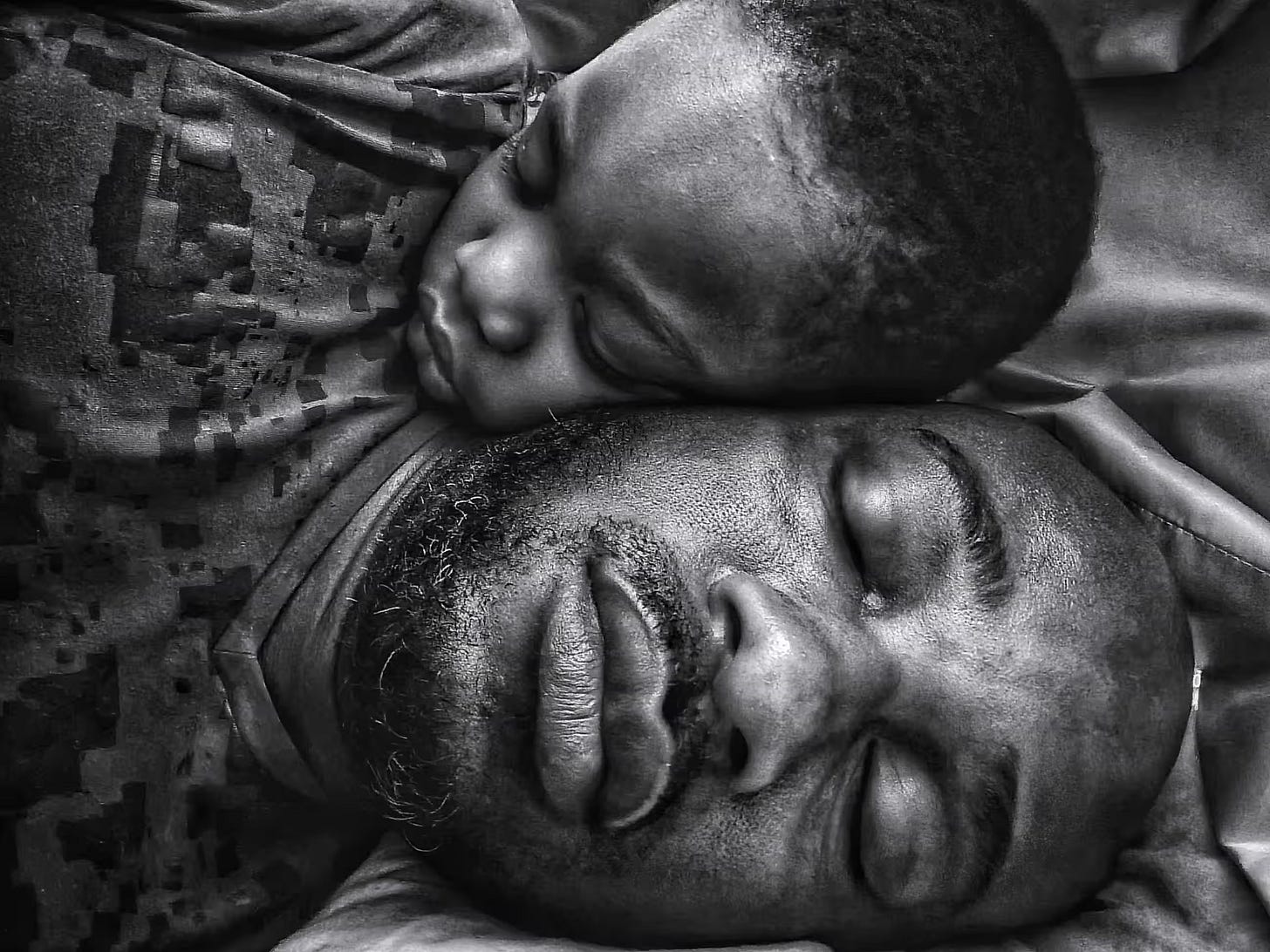#17 'Gentle to the ways of the world'
A few highlights from Sharjah Biennial 16, some glorious new tunes, a walk along Singapore's edges
I’m just back from Sharjah, in the UAE, where I went to write about the biennial (you can read that here) : a magical onslaught of art and ideas, weavings, archives, actions, gestures, readings, songs and sounds, by some 190+ artists. You can listen to my interview with Sheika Hoor Al Qasimi, the director of the biennial here.
The reason I wanted to go in the first place was this, the titular poem with which the five curators—Alia Swastika, Amal Khalaf, Megan Tamati-Quennell, Natasha Ginwala and Zeynep Öz—introduced their concept for the whole thing:
to carry a home to carry a history to carry a trade to carry a wound to carry equatorial heat to carry resistance to carry a library of redacted documents to carry rupture to carry Te Pō [the beginnings] to carry change to carry songs to carry on to carry land to carry the language of the inner soul to carry new formations to carry the embrace of a river current to carry sisterhood and communal connection to carry the rays of a morning without fear
Of the many pieces that really grabbed me, the Womanifesto archive (the above drawing is just one small item) was one in particular, that had me all choked up. I think that is because of the very tangible care at the core of the work.
Womanifesto is a Thai artist exchange collective, which, in Sharjah, is exhibiting archives of the gatherings and residencies it organised in the 1990s and 2000s, bringing together women from all over. I think it was this idea that, way before the wider artworld started properly paying attention to the overlap between motherhood and artmaking, there were all these women just doing it, making space for each other to make work.
One scholarly essay on Womanifesto and other similar collectives quotes curator Ilaria Conti as saying that: “Artistic expression takes its ability to speak from, to, and for communities from a spectrum of communal practices that aren’t meant to be eradicated from life and placed in the institution, as they are part of a broader continuum of knowledges and experiences.” She references the Guatemalan artist Benvenuto Chavajay Ixtetelá, who has said in Tz’utujil language, there is no word for “artist”: the term used, q’omaneel, is the same used to denote doctors, musicians and other kinds of practitioners whose activities overlap in terms of healing and communal living.



In fact, if I step back from the 650+ works included in the biennial and try to find marbles, as it were, that might contain or represent them all, I’m left with two words: “translation” and “love”. All those artists are from communities the world over—not just nations, but oftentimes, peoples marginalised within country boundaries, those who don’t have nations.
Most of the works thus speak to specific places (via ancient traditions, handed-down knowledge, languages and perspectives), but not in the way ethnographers and anthropologists have so long operated, removing objects from their contexts and gestures, from their roots. Here, nothing is exoticised because whomever’s work it is is speaking from the inside: it’s a series not of “look over theres” but “come sit heres”. Hence the translation (as the viewer, at best there’ll only be one or two “heres” that are yours; in other words, the longer you sit, the more you realise you do not understand— and that’s humbling). So too, the love (the artist, saying, I am from here, feel my care, the love I have for this here, for these my people).
Here are a bunch of other things I’ve carried around in my pocket for you over the past couple weeks.
Dotun Ajao AKA McAwhy’s best phone picture: how tender, this moment. I love the last paragraph: “After taking the photo, Ajao tried to sleep, but only managed a few minutes before he had to get up and continue his day. He manoeuvred himself gently from beneath his son. Ireayo slept on.” Ireayo slept on. I keep thinking about that.
A collection of gentles I thought of yesterday, as I was walked home from Angel:
•That moment in Interstellar when David Gyasi’s beautiful character, Romilly, suggests to Cooper (Matthew McConaughey) that they send Tars over Gargantua’s horizon, because it’s “an older, spinning black hole — what we call a gentle singularity.”
“Gentle?” asks Cooper.
“They're hardly gentle,” Romilly replies, “but their tidal gravity is quick enough that something crossing the horizon fast might survive...a probe, say.”
•How my daughter TsuTsu, when she was little, thought Nell’s daughter Betsy was called Gentle and that they lived in the warehouse next to our flats.
•How Philip Pullman uses “gentle” as a verb in The Northern Lights trilogy: “Pantalaimon fled to Lyra at once, and she scooped him up to her face to kiss and gentle.”
•Zach Bryan’s spoken word piece, Lucky Enough, in which he has this line:
“If I'm lucky enough, I will get through hard things
And they will make me gentle to the ways of the world”This bit in Patrick Modiano’s Scene of a Crime (tr me for the first line and Mark Polizzotti for the other two) (I’ve not included the whole passage, just these three fragments):
On the old Geological Survey map, the distances no longer matched what Bosmans remembered.
If the Geological Survey map contradicted his memory of the place, it was no doubt because he had passed through the area in various stages of his life, and the years had ended up shortening the distances.
He tried to reconstruct a kind of Geological Survey map of his own, but with holes, blanks, villages, and back roads that no longer existed. Little by little, the routes came back to him.
This piece on a new approach to urban regeneration and what intangible cultural heritage looks like in a contemporary city, referencing both cult NYC locales, like the Stonewall Inn, and Shinto shrines in Japan: “Dating back more than 2,000 years, Ise Jingu shrine is ritually dismantled and rebuilt, in keeping with Shinto beliefs and practices. So the actual shrine isn’t ever older than 20 years. The intangible heritage is the construction process itself. ‘Miyadaiku’ — carpenters and artisans trained in the ancient traditions required to rebuild the shrine — are its custodians.” Which is exactly what chief architect of Notre-Dame Philippe Villeneuve references for what he calls “authentic restitution”, his new paradigm for restoration.
Here’s a really lovely 30-min visit of Ise Jingu. The next rebuild is set to take place in 2033 and I really want to write about it.
Hiraki showing this beautiful work shot in Toronto in the 1990-2025: Art, Architecture, Nature exhibition at Kawamura Memorial DIC Museum of Art until 31 March.
Jewish-American photographer Hannah Altman's new book, We Will Return To You (Saint Lucy Books, March 2025) — an enigmatic series, steeped both in Talmudic mysticism and Yiddish folklore. Altman has long been exploring Jewish memory, ritual and storytelling. She describes her work as answering the question, "How do we structure the themes, anxieties, and messages that we so fervently want to remember for generations to come?" and draws a parallel between Jewishness and photography in both being “haunted by marking time”.
Altman’s title makes me think of Arrival, and how Louise (Amy Adams)’s first and last words—both her to her daughter, and the film to us—are “Come back to me, come back to me”. A gentle circularity.
This story about Armia Malak Khalil, a security guard at the Met, in NYC, having a conversation with a viewer to the Egypt section — who, it turned out, was one of the museum’s curators, Akili Tommasino, working on a show, titled Flight into Egypt: Black Artists and Ancient Egypt, 1876-Now. Khalil mentioned he was from Egypt, and that he was also an artist, and pulled out his phone to show his work. And, as he subsequently put it, “Magic happened here”: the curator put his work in the show.
These football ranking tables and the obsessive journos at The Knowledge who find them museum-worthy in their import: they think they should be put in the Louvre.
This online show of gardens, flowers and landscapes in 20th-century British painting …
… and this 20th-century British painter in particular, Paule Vézelay, who I have written about for this weekend’s Guardian Saturday mag (the piece is already up here). What a dame.


The new album, SABLE fABLE, Bon Iver’s just announced, for release in April. Justin Vernon released a first single, Speyside, a while ago; now two more are out, Things Behind Things Behind Things, and Awards Season. Given that I’m still not done listening to all four of his first albums on repeat repeat repeat, as well as his work with Aaron Dessner as Big Red Machine, and his earlier work with `Vocano Choir and everything in between, this is awfully good news (all tunes in playlist below).
My favourite Song Exploder episode where Hrishi dissects Holyfields, from Bon Iver’s last album, i,i—a frankly miraculous song, as loose as a puff of smoke drifting to the rafters, with these harmonies that hold together with little more than breath and a string chord resolve at the end that will never not get me choked up. I do wonder, often, about this, the enduring power that a bit of music just 20 seconds long can continue to exert even after you’ve listened to it a billion times and you know exactly what is coming.
Mustafa’s I’ll Go Anywhere <3
Piers Faccini and Ballaké Sissoko’s new album, Our Calling, which came out at midnight last night and instantly had me in tears. The way Sissoko’s kora melds with Faccini’s guitar and his lyrics both. One Half of a Dream is reminding me of Nick Drake and also of Nico’s These Days.
Also out today, Park Jiha’s 𝐴𝑙𝑙 𝐿𝑖𝑣𝑖𝑛𝑔 𝑇ℎ𝑖𝑛𝑔s, which I told you about the other week and which I’m putting in today’s playlist.
The single Germany-based Mongolian singer Enji released on Tuesday, ahead of her forthcoming album, Sonor. The title of the song is Ulbar, which is the Mongolian word for the colour of the sky at dusk. Enji has said that she often misses out on sunsets, because her mind is still racing in the pace of the day. “Not long ago, I watched an ‘ordinary’ sunset, following every colour and their shifts, always blending, merging and inviting others. The colours melted from gold into amber, as if the sun was cooling down. This song talks about that scene.”
Heman Chong’s excellent Perimeter Walk, installed in Sharjah in the Old Al Jubail Vegetable Market: 550 postcards taken during these walks the artist routinely does along Singapore’s edges. I asked him if the photographs are a record or a mapping of the route and he said, no, they’re more like a dream, the kind of meander your mind goes on when you let it be while you walk. He also said the walking started as a means to protect or nurture his mental health and that is something I can relate to most profoundly. The cards are displayed in a shelf that stretches up towards the roof, and visitors can help themselves. I’ll treasure mine.


Heman Chong, postcards from Perimeter Walk. Suzanne Lacy’s The Circle and the Square. It is installed in the Al Qasimiyah School in Al Manakh, in Sharjah City. My friend Akin and I sat and watched it for what felt like a small lifetime and I’d have stayed for two lifetimes, but an ill-advised performance started midway through, in the adjoining inner courtyard, and I can’t tell you how much that bombastic bass spoilt the moment. Lacy shot this multiscreen work between 2015 and 2017, in the north-east of England. The centrepiece is a two-screen projection featuring one group of people sitting in a square formation, singing Sacred Harp-style shape music from the American north east and Appalachia, and another group of people, mostly imams, sitting in a round, chanting Sufi patterns together. There’s a moment when the imams are almost all just humming, their eyes closed, and it is extraordinary. You can watch documentation of the project here. Or rather, you can listen. Just listen and listen and listen.
World of Echo
Walking as a state of mind
In 2021, Yeo Ying De and his “garang [bold, fierce] sister”, Ying Tong, mapped out a 150km walk they did around Singapore, and got a spot on a world record list. I’d quite like to find someone who has every-single-streeted the island.
Pull up a memory
This week Avery sent me a dream (“We were hanging out and going to coll cafes and bars open late with big tables. And you showed me a new use for an emoji: 📜, reacting to a message with a scroll to communicate ‘I am suing you over this comment’”, properly funny. Also, dream emojis. YES.)
Tracy sent me a voicenote to say her son, the brilliant archeologist David Mendel Witelson is coming to do a post-doc in Oxford, which is thrilling. I imagine he will work with the legendary Shadrek Chirikure, who I spoke with last year regarding the properly amazing living encyclopedia he recently edited, the Oxford Encyclopedia of African Archeology.
And Susu sent me this newspaper cutting. I love getting things in the post, virtual or on paper.
“Ich will das Salz der Erde sein und vererben ein verzöhntes Haus” <3








